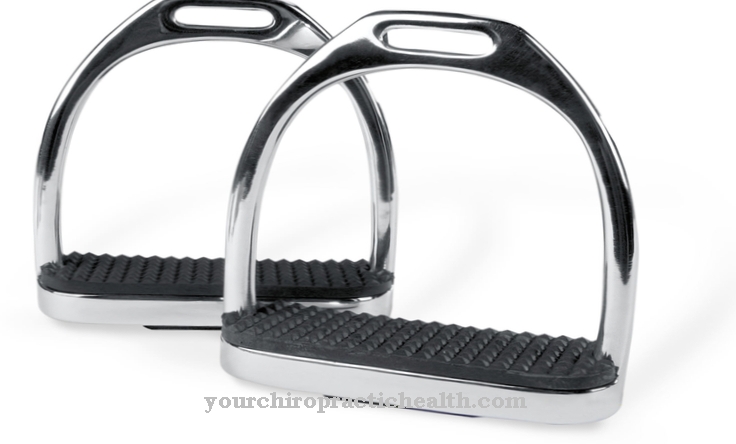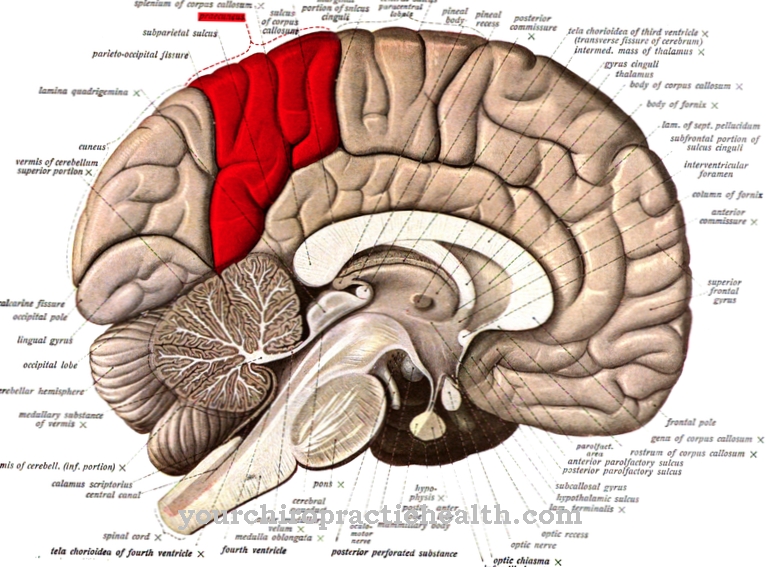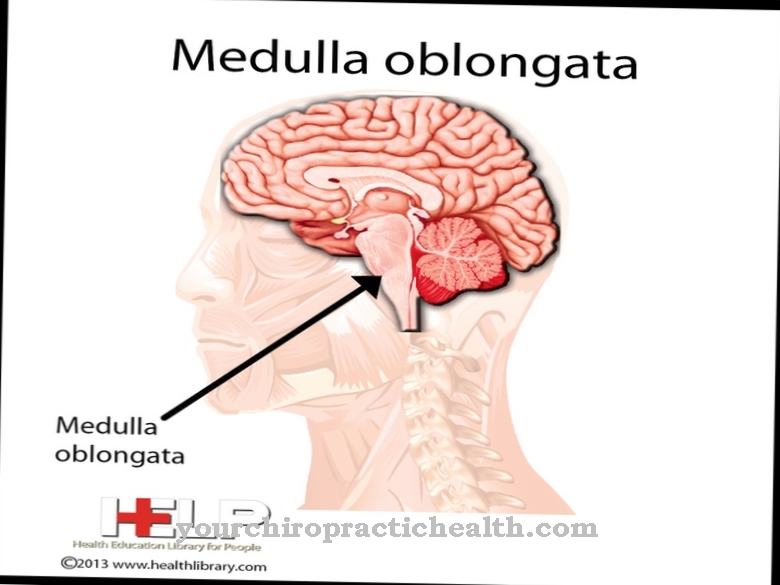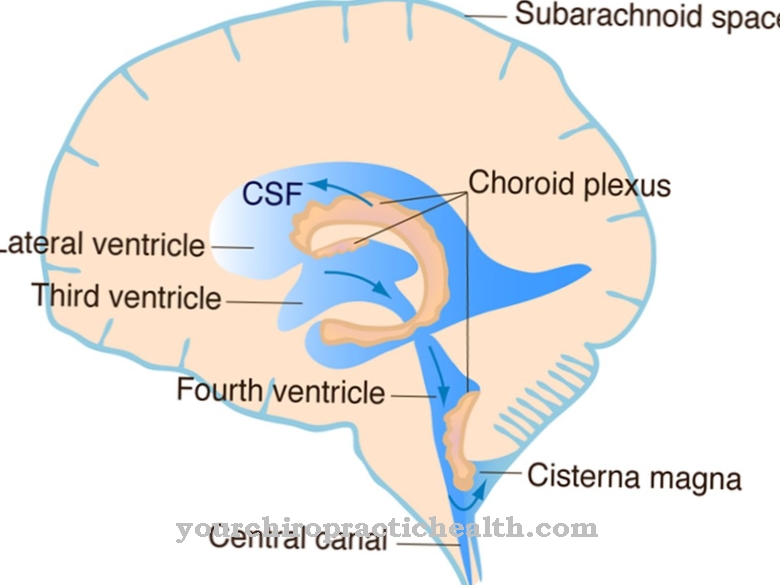The three paired and equipped with mechanoreceptors Semicircular canals in the inner ear belong to the organs of equilibrium and are almost perpendicular to each other, so that a semicircular canal is available for each of the three main directions of rotation in three-dimensional space.
The semicircular canals react sensitively to rotational accelerations, but not to uniform rotations. They are filled with endolymph, which, due to the principle of inertia, starts to move when it is accelerated and bends small sensory hairs that emit a corresponding electrical signal to the vestibulocochlear nerve.
What are the semicircular canals?
The three semicircular canals located in the petrous bone of the inner ear together with the two otolith organs sacculus and utriculus form the paired equilibrium or vestibular apparatus. The functional principle of the semicircular canals is based on the inertia of the endolymph, which is located in the semicircular canals.
In the event of a rotational acceleration, which can also be caused by a rapid rotation of the head, the endolymph of the semicircular canal, which is located in the plane of rotation, remains momentarily. In the ampulla, the lower thickening of the semicircular canal, there is a mechanoreceptor with sensory hairs that are bent by the movement of the endolymph and send a corresponding signal to the vestibulocochlear nerve. Stopping a rotary movement is also perceived as an acceleration, but as an acceleration in the opposite direction.
The semicircular canals react extremely quickly to rotational accelerations due to their operating principle. A disadvantage is that the endolymph briefly "twists" after each acceleration before it comes to rest again in its original position. During the calming phase, which can last up to a second after a pirouette, an acceleration is felt subjectively, although objectively there is none.
Anatomy & structure
The small, tube-like semicircular canals in the membranous labyrinth in the left and right inner ear all arise from the vestibule, with which the two otolith organs are connected for the sensory detection of linear accelerations. The semicircular canals each have a thickening at one end directly above the vestibule, the crista ampullaris, in which the end of the receptor cell is located.
A small capsule, the cupula, bulges over the crista ampullaris, which is filled with a gel and into which the sensory hairs of the mechanoreceptor protrude. The crista with the cupula sitting on top practically closes the semicircular canal at this point. Because the endolymph, which fills all the vestibular organs, moves briefly against the walls of the semicircular canal due to its inertia during a rotational acceleration and "takes" the cupula with it, the sensory hairs are bent and generate an electrical potential that they pass on to the vestibulocochlear nerve.
The entire membranous labyrinth is surrounded by perilymph, which is distinguished from the endolymph in the vestibular organs by a reversal of its electrolyte ratios. The endolymph is rich in potassium and low in sodium, while the perilymph, which is identical to the extracellular lymph of the rest of the body tissue, is low in potassium and high in sodium.
Function & tasks
The most important task and function of the semicircular canals is to "cooperate" with the otolith organs, the proprioceptor system, also known as the proprioceptor system, and to keep the body in balance and to trigger certain eye reflexes. An important reflex is the vestibulo-ocular reflex (VOR), which makes it possible to fix an object firmly even with very fast head movements.
The vestibular organs are connected directly to the eye muscles and trigger involuntary corrective movements of the eyes against the direction of acceleration, which can be much faster than voluntary eye movements. Another advantage of the VOR is that you can easily keep an eye on the stationary environment, even with complex movements such as running and jumping. The effect is somewhat comparable to a gyro-stabilized camera in use on moving platforms.
The acceleration reports of the semicircular canals are very fast, significantly faster than central vision, because the brain has to provide far less “processor work” for vestibular reports than with central vision. The interaction of several sensor systems for the coordination of movements has the advantage that one sensor can compensate for the failure of another at least for a certain time. In this way we can stand upright even in complete darkness and walk despite the loss of sight.
Unfortunately, the semicircular canals supply false reports for a short time after each stopping an acceleration, because the endolymph lags a little due to the inertia, so that the sensory hairs remain briefly distracted and report "wrong" acceleration impressions. If at that moment there is a good view of the surroundings or reference surfaces, the brain takes the visual impressions as "correct" and suppresses the "incorrect" movement impressions within less than 100 milliseconds.
You can find your medication here
➔ Medicines for earache and inflammationDiseases
The most common complaints related to the semicircular canals are so-called dizziness, which can be very uncomfortable and can be traced back to various causes.
Dizziness as a key symptom - also in neurology - is understood to mean symptoms such as incorrect perception of movement. The dizziness can be accompanied by headaches and nausea or vomiting. Benign peripheral paroxysmal positional vertigo (BPPV) tops the frequency list with around 17% of the causes of all vertigo symptoms. It is a benign disease that may have been preceded by a traumatic brain injury or an inflammation of the vestibular nerve. The BPPV is caused by the detachment of one or more calcite crystals from one of the two otolith organs and their displacement into the posterior semicircular canal. This is possible because the endolymph is connected to one another.
Even if the symptoms can be serious, the problem can be solved by appropriate body positions, because the crystal grain can leave the semicircular canal again in a natural way. In addition to some other causes of dizziness such as neurotoxins, alcohol and other poisons, Menière's disease is a relatively common reason for the appearance of symptoms with around 10%. Menière's disease is based on overpressure of the endolymph in the inner ear. Severe attacks of dizziness are usually accompanied by tinnitus and incipient hearing loss.



























